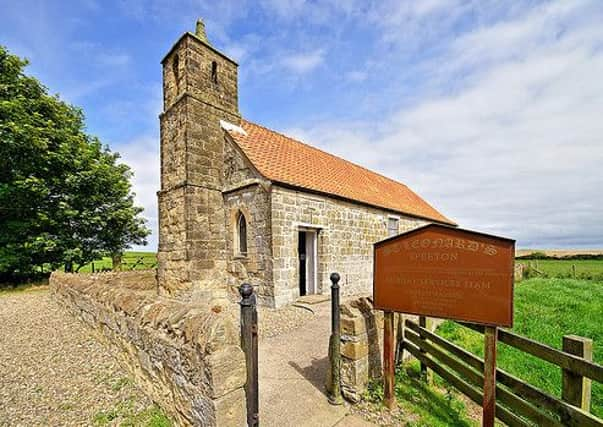Your Day Out: Hard-working community


Tucked away to the lea of those cliffs lay the hamlet of Speeton. Just beyond the church, the village pond, or ‘mere’ completed the scene. Bathed in the evening light stood a figure feeding the ducks. This kindly stranger proved to be Robert Taylor. He invited us home to meet Doreen, and dog Toby.
Bob’s home was his castle. ‘Mereside’ was his own construction, overlooking the ‘mere’, and quaint Saxon church. Beautiful wood-carvings adorned the home of this talented, humble countryman.
Advertisement
Hide AdAdvertisement
Hide AdA ‘moongate’ comprising 86 horseshoes opened into a wondrous garden. In the front garden was a treasured keepsake – a millstone. It was the last remaining part of the mill – the end of an era.
As a lad, born in Speeton, he made the fire and filled the side boiler with water from a tub. No running water until the 1930s. It was carried in gallon buckets from the village pump at the bottom of Mill Hill. There was no electricity, nor flushed toilets, only earth closets, so Bob was chief hole-digger too!
School days at the old Reighton/Speeton school (built in 1876) were happy ones. Fifty children attended between 1924-1933.
A red-letter day was May 24, Empire Day. A large Union Jack was fixed above the porch. All marched round and saluted it.
Advertisement
Hide AdAdvertisement
Hide AdChristmas meant the loftiest tree from Beacon Plantation could be decorated. Major Willet from Reighton Hall was Father Christmas. Later, Bob undertook this role for 23 years. The last party was in 1986 with only 15 pupils present. The school closed in 1987, and then served as The Honeypot Inn.
Pocket money was earned by collecting and delivering cans of milk for the princely sum of sixpence a week, or opening and closing gates for another sixpence.
Life was one of contentment in the early 1920s. There were three large farms, two small ones, and ten chalk houses used as tied cottages for farm labourers. Four or five teams of horses ploughed the land. All were then fed, watered and brushed down. An evening’s relaxation was usually a game of cards.
Crops were mainly corn fed, and turnips for the sheep. With no cars or buses, children played in safety, happy to kick a tin around, play with a hoop, or a whip and top.
Advertisement
Hide AdAdvertisement
Hide AdA roadman swept the streets and scythed the verges, meeting farmers and gentry for miles around. He became the village oracle!
All were content. The little shop at the bottom of the village provided everything. Next door was the blacksmith’s shop.
On the hill north of Speeton, the mill was a landmark and navigational aid for many years. Erected in the early 1800s with four sails, owing to its exposed position, two sails had to be removed! It provided animal meal and a little wholemeal flour. When fine white flour from Driffield’s mills became popular, Willie Plewes’ mill closed down between 1850-1860.
Bob’s father helped demolish it in 1921. Others helped clean all the bricks which helped Sawdon Bros of Filey build the first six council houses down Wide Lane.
Advertisement
Hide AdAdvertisement
Hide AdA coastguard station stands near the windmill’s site almost 400ft above sea level. Built about 1906, it was manned by ex-naval personnel and a life saving apparatus crew of 20 men – the entire male population.
From the three shipwrecks, Bob’s father salvaged blocks of butter, ship’s biscuits and coal.
Bob was parish councillor for over 20 years. He devoted his time and talents to helping the local community. He had a new memorial made for the church, recording men and women of Speeton who fought in the Second World War. Only one Speeton man was killed - Henry Moon of the Green Howards.
Bob also volunteered to restore the village pump to its former glory, assisted by a team of willing helpers.
Advertisement
Hide AdAdvertisement
Hide AdAs there was a beacon on Beacon Hill in 1558, bonfires have since been lit there to commemorate special occasions. Queen Victoria’s ascension to the throne was celebrated in 1837 followed by coronations and jubilees.
Horses and traps have given way to buses and cars; horse power replaced by machines; the village ‘oracle’ by telephones and mobile phones etc. Street games have declined. Youngsters have turned to televisions and computers. With no village shop, mobile bakery, butcher, fish monger, and green grocer paid regular visits to Speeton.
The little church, with its Danish tower and Saxon chancel arch, remains steadfast. It serves as a reminder of the generations who have worshipped there, and must be visited.
What a hard-working community Speeton has been, with a bond of friendship uniting them. Small is beautiful, and these people, devoted to God and mankind, is an example to all.
Advertisement
Hide AdAdvertisement
Hide AdAs you sit on one of Bob’s cliff top or village seats, ponder how life has changed over the decades.
Leaving Speeton, engraved in my memory will always be Bob’s wood carving of St Leonard’s Church, which perhaps took pride of place in their home and hearts.
Refreshment: The Honey Pot Inn.